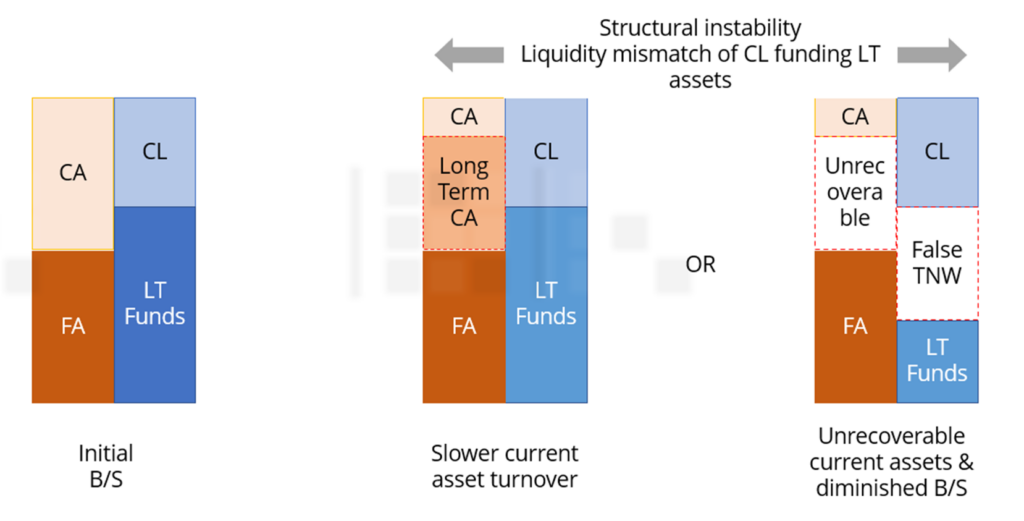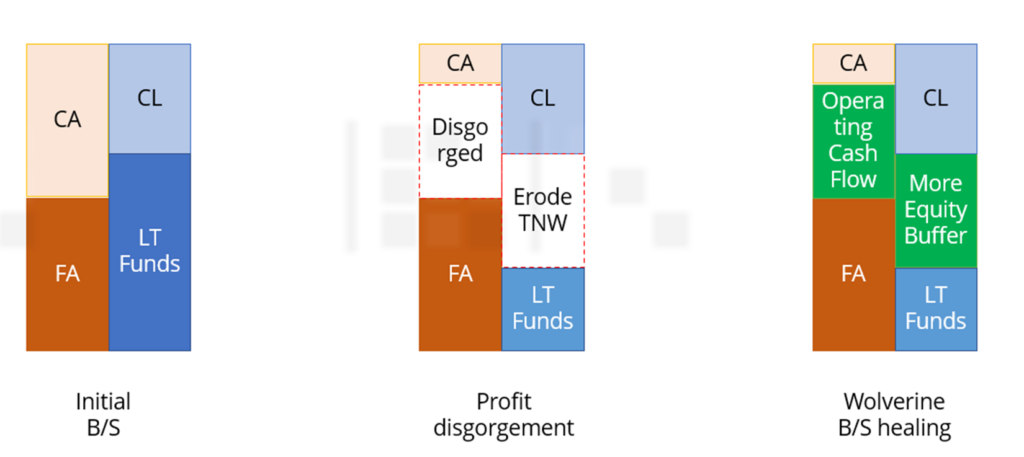Deep Dive Liabilities + Equity B/S Analysis
- Reclassifying the liabilities + equity side of the balance sheet to better understand the sources of capital and Jeremy’s Jenga
Common Mistakes
- Networth definition includes loans due to directors but does not exclude loans due from directors
- Never find out why audited accounts are qualified
- Review on unchanged basis = don’t need to re-assess needs of clients against the financials
- Double counting of rental savings
- Never find out what is other income when other income consistently is the factor for positive NPAT
Capital Structure
- What is the firm’s leverage ratio?
- What kind of debt has the firm taken on?
- What is the firm’s DSC ratio?
- Has the firm been deleveraging?
- Has the promoter been using his own funds to pump into the business? If so, is he scraping the bottom of the barrel?
- Has the promoter recently raised funds through rights issues/private placements?
- Is the firm listed? Is its MV the same as its BV?
Deep Dive Assets B/S Analysis
- Reclassifying the asset side of the balance sheet to better understand the company
Asset Conversion
- Concerns the payback period of asset. Focus on the cash conversion cycle and LT cashflows (total assets)
- Land vs. Equipment
- Inventory (consider if it is perishable)
- Note the limitations of accounting classifications
CAPEX
- Be aware that the firm may dispose assets to increase CFI rather than spend on new assets
- Can the asset (land, real estate, machinery) be sold at a market value higher or lower than its historical value?
- Liquidation of assets lengthens the DDD
- However, consider if this liquidation affects future UEA!
- Companies that are making losses (profitability) are usually unable to replace equipment and asset base
Structural weakness – “Non-current” / Unrecoverable CA

Wolverine – Repairing B/S post recapitalisation

Deep Dive AR/AP Analysis – spot the Grey Rhino
- AR and AP analysis can show you more than what you can see in the 3 financial statements. If you know how to use it to your advantage, you can spot the grey rhino and ask the right questions that can have a substantial change to your credit analysis.
Accounts Receivables
- Quality of AR
- Country
- Currency
- Ageing (any island debtors?)
- RP
- Trend
- Consider credit terms
- Assess and adjust materiality of AR from related parties against TNW, affects leverage/gearing ratios, affects rating
- Discontinued business outstanding AR generally uncollectible (debtors do not have incentive to pay as they are no longer dependent on B for supply)
- Industries like retail and restaurants should not have long AR (red flag if ARDOH is long)
- AR is a source of cash for subsequent repayment of bank debt
- Compare AR across a few periods (identify if any key debtors are dropped off indicates cessation of relationship will impact B’s topline
- Unique cases
- Individual Chinese names instead of corporate names Why? Remittance issues
- Conduct enhanced due diligence, AML issues
- Obtain invoices and payment records to match / trade docs
7 Types of AR Concentration Risk
- Geographical
- Capital controls – stop buying foreign currency, don’t want domestic currency to flow out
- Transfer and convertibility risk
- Product
- Buyer (number of debtors)
- If you sell to different subsidiaries under the same Group.. Depends on how big and reliable each subsidiary is. Whether each subsidiary can be regarded as a separate
- Are there similar patterns in terms of non payment? Island debtors
- Currency
- Must see the ultimate buyer… UEA… the buyer (AR debtor) sell in local market, will have currency risk (if material)
- So even though the AR aging lists SGD only but UEA may have currency risk (especially if you see foreign companies in the AR aging)
- See the historical depreciation of the currency – knock it off by worst case (eg. 30% or 50%) and see if the equity buffer can take it
- Long term decline.. No point waiting
- AR aging bucket
- On a portfolio basis whats the normal range
- Buyer Industry
- Credit quality of buyer
- If your buyer are the Bank’s customers, will have info
- Use credit bureau
- For property financing, you want to check on the tenants
- Sometimes, the credit quality of your buyers are very good such that it serves as credit enhancement (eg governments or government agencies)
Look out for the Island Debtor
- •Look for possible asset impairments (i.e. AR): (1) is it a one off default? (2) single outlier? (3) is it industry practice to have long AR DOH?
- Compare AR listing and look at each company transaction across months à identify AR provision MoM
- Is there a pattern in the single AR list (Materiality relative to Equity Buffer)
- Are there changes across AR lists?
- 6 correlation attributes of AR ageing: Debtor, Industry, Geographical, Currency, Credit Rating
Acquisition

Structural weakness – “Non-current” / Unrecoverable CA

Wolverine – Repairing B/S post recapitalisation
